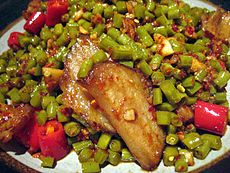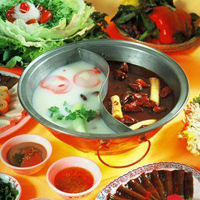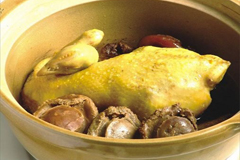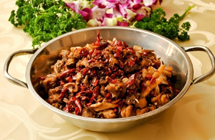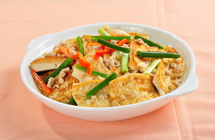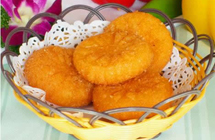
Hunan cuisine, also known as Xiang cuisine, consists of the cuisines of the Xiang River region, Dongting Lake, and western Hunan province in China. It is well known for its hot spicy flavour, fresh aroma and deep colour. Common cooking techniques include stewing, frying, pot-roasting, braising, and smoking. Due to the high agricultural output of the region, ingredients for Hunan dishes are many and varied.
Background
| The history of the cooking skills employed in Hunan cuisine dates back many centuries. During the course of its history, Hunan cuisine assimilated a variety of local forms, eventually evolving into its own style. Stewed fins, fried fresh cabbage with chestnuts, Dong Anzi chicken, immortal chicken with five elements, are of the highest reputation. Chairman Mao, together with other leaders praised the Hunan cuisine in 1958. It now contains more than 4,000 dishes, such as fried chicken with Sichuan spicy sauce and smoked pork with dried long green beans. Hunan cuisine consists of three primary styles: | |
| Style | Regions it originated from |
| Xiang River | Changsha |
| Xiangtan | |
| Hengyang | |
| Dongting Lake | Yueyang |
| Changde | |
| Western Hunan | Zhangjiajie |
| Jishou | |
| Huaihua |
-------------------------------------------------------------------------------------------------------------------------------------------------------------------------
Features
| | Known for its liberal use of chili peppers, shallots and garlic, Hunan cuisine is known for being dry hot or purely hot, as opposed to Sichuan cuisine, to which it is often compared. Sichuan cuisine is known for its distinctive mala (hot and numbing) seasoning and other complex flavour combinations, frequently employ Sichuan peppercorns along with chilies which are often dried, and utilises more dried or preserved ingredients and condiments. Hunan cuisine, on the other hand, is often spicier by pure chili content, contains a larger variety of fresh ingredients, and tends to be oilier. |
Another characteristic distinguishing Hunan cuisine from Sichuan cuisine is that, in general, Hunan cuisine uses smoked and cured goods in its dishes much more frequently.
| Another feature of Hunan cuisine is that the menu changes with the seasons. In a hot and humid summer, a meal will usually start with cold dishes or a platter holding a selection of cold meats with chilies for opening the pores and keeping cool in the summer. In winter, a popular choice is the hot pot, thought to heat the blood in the cold months. A special hot pot called yuanyang huoguo ("lovers' hot pot") is notable for splitting the pot into two sides - a spicy one and a non-spicy one. | |
-------------------------------------------------------------------------------------------------------------------------------------------------------------------------
Foods
Immortal chicken with five elements
| | Immortal chicken with five elements means to put five elements, litchi, longan, red dates, lotus seeds, and medlar, into the body of a chicken, then to braise. The taste is rather peculiar but it is said to have the effect of strengthening the constitution. |
notable dishes
| | | |
| "Dry-wok" chicken | Homemade-style bean curd | Pumpkin cake |
Written by Nicolas Yang

